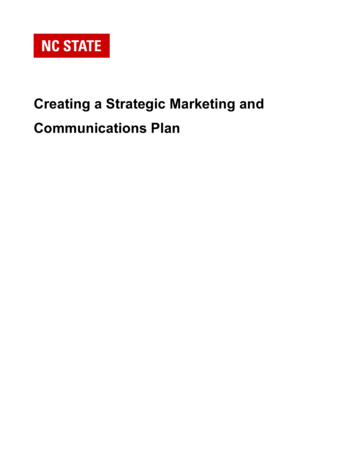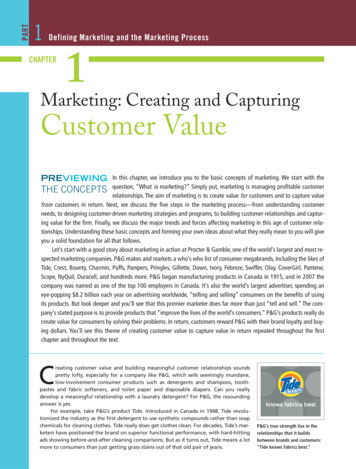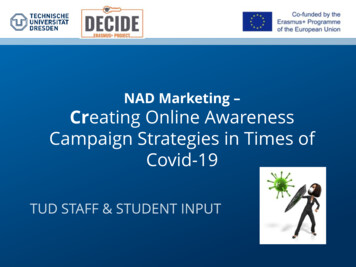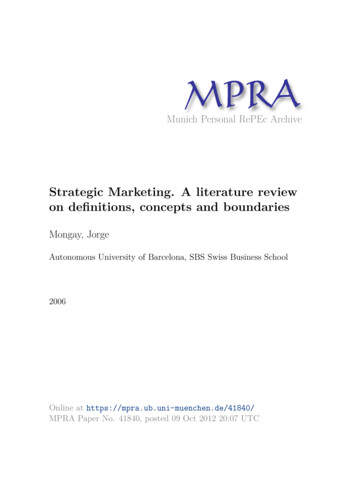
Transcription
Creating a Strategic Marketing andCommunications Plan
Table of ContentsCreating a Strategic Marketing Plan03SWOT Analysis Tips08SWOT Analysis Template09Audience Analysis10Voice and Tone Chart11On-Brand Marketing Message12Tactical Implementation Chart12Tactical Implementation Worksheet14Project Brief16Basic Marketing Plan Summary19
Creating a Strategic Marketing PlanThis marketing plan template is designed to facilitate analysis, planning and communication of your strategicmarketing and communications plan. Additional resources and worksheets are references throughout thedocument to assist with more detailed planning in specific areas.Before writing your plan, determine the time-frame for your plan. Is this a three-year plan, a five-year plan, etc?Regardless of the time frame, the plan should be reviewed and updated yearly as needed.Step I: Establish a Marketing Planning CommitteeThe first step before beginning work on your marketing plan is to establish a marketing committee that willoversee the marketing plan development process. Developing a marketing plan shouldn’t be done in a vacuum.Everyone is your college, department or unit is a spokesperson for your brand, so varied perspectives andvoices should be involved in developing your overarching communication plan.We suggest developing a committee comprised of the following members:Dean and LeadershipCollege/Department or Unit Director of CommunicationsUniversity Communications Marketing RepresentativeUniversity Communications Public Relations LiaisonCollege/Department Admissions Representative (if you are associated with a college or department)Faculty member(s)Director of DevelopmentCommittee Purpose and Charge: This committee should meet at least once per semester. The purpose ofthis committee is to discuss major issues related to marketing and communications for your college/departmentor unit. This committee is a sounding board for the overarching direction for your marketing needs.Step 2: Establish a Marketing Plan Work GroupThe Marketing Planning Committee will provide direction and oversight for the strategic marketing plan, but thereality is that writing a marketing plan is a nuts and bolts process which needs a core Marketing Plan WorkGroup to see its completion.You’ll want to establish a small group to actually write the marketing plan which will be shared with theMarketing Planning Committee.Your small work plan group should consist of:College/Department or Unit Director of CommunicationsUniversity Communications Marketing Representative
University Communications Public Relations LiaisonSomeone in your college/department or unit who is passionate about communication and marketing(optional)This team should meet at least monthly during the marketing plan development process. Meetings may need tobe more or less frequent depending on where your group is in the planning and writing process for your strategicmarketing plan.Step 3: Writing the PlanWriting a marketing plan can seem like a daunting task, but it’s really just the process of codifying andprioritizing all your marketing ideas into a single, overarching document that serves as a communications roadmap for your college, department or unit. Your marketing planning committee’s ideas will help shape thedocument and your small marketing work group will do the heavy lifting of compiling the ideas.All marketing plans should directly support your college department or unit’s strategic plan. The marketing planoutlines how communication strategies will support and enhance strategic plan goals. If your group does nothave a strategic plan, the University’s strategic plan can be used the anchor for your communications priorities.Outlined below is a suggested structure for your marketing plan. You’ll also find supporting documentation anddescriptions for each element.A. Executive SummaryThe first part of your marketing plan should actually be written last. Once you’ve written your marketing plan,you’ll want to provide a 30-thousand-foot overview of the plan for those who just want the highlights.B. Situational Analysis/ResearchThe Situational Analysis is a chance for your college, department or unit to reflect on the current internal andexternal environment relating to your organization. The Situational Analysis is an analysis. It uses data,research, trends and observations to assess the current state of things within your college, department or unit.The Situational Analysis does not have to relate to communications specifically. It should describe theoverarching state-of-things so that everyone understands the challenges and opportunities your organization isfacing.A Situational Analysis can be as simple as a SWOT (Strengths, Weaknesses, Opportunities, Threats) analysis,or it can be more in depth and provide additional data. At a minimum, University Communications suggestscompleting a SWOT exercise with your Marketing Planning Committee and including it in the SituationalAnalysis. Other elements you might include in a Situational Analysis:Historical narrativeSWOT analysis (See SWOT Analysis Tips and SWOT Analysis Template worksheets)
Competitive set analysisSecondary NC State research - Admissions, Alumni surveysSecondary trade/industry researchPrimary market research - Awareness, market testing, focus groupsC. Audience Analysis (See Audience Analysis worksheet)One of the most critical components of any marketing plan is narrowing your target audiences. Often communicatorswill assume their target audience is “EVERYONE,” but unless you have a 4 billion dollar marketing budget or areCoca-Cola, it’s unrealistic to think that your messaging is for everyone. Segmentation of your audience andmessaging improves the effectiveness and penetration of your message.They key to a quality marketing plan is determining your most important and influential audiences to meet yourmarketing objectives. Encourage your marketing planning committee to brainstorm potential audiences. After yourinitial brainstorm, you’ll want to prioritize audiences. Having 50 potential audiences makes for a challenging andexpensive communications strategy. Try to put your audiences into buckets of primary, secondary and other. Thiswill help you to prioritize and target your messaging.For each audience selected as a target, provide some background information and characteristics. What doesthis target look like? What are their interests? How do they consume information? What are their perceptions ofour college/department or unit?Primary AudienceTier 1(Must have their support and ear.)Secondary AudienceTier 2(Important, but no primary)AlumniDonorsStudentsFacultyOtherTier 3(Nice to have)
Primary ent Mindset /RoutineBarriersWhere theyAccessInformationPrimary Audience 1Primary Audience 2Secondary Audience(s)AudienceDescriptionSecondary Audience 1Secondary Audience 2DesiredBehaviorsCurrent Mindset /RoutineBarriersWhere theyAccessInformation
Other ent Mindset /RoutineBarriersWhere they AccessInformationD. Key Messages (See NC State Voice and Tone and On-Brand Marketing Messages worksheets)After establishing target audiences, the next step in writing your marketing plan is to determine your key messages.The emphasis on these key messages may vary depending on your audiences, but the messages should be theessentials of your “elevator pitch” to the world.What are the key things that everyone in the college, department or unit be sharing with the world? What are themessages that we want people to hear over and over and over again so that they begin resonating in themarket? Who are we? Where are we going? What do we stand for? These messages should be bold, succinctand complement the NC State brand platform.Each message should be backed up with supporting facts that bolster your message. Try to focus onmessaging. Less is more.Examples:Key Message 1: Our college fosters new knowledge that impacts economic and societal prosperity.Supporting fact: We have a #1 ranked research program.Supporting fact: Our graduates have created 20 start-up companies in the past 5 years.Supporting fact: Etc.Key Message 2: We are an innovative, fiscally responsible college worthy of investment.Supporting fact: We’ve increased donations by 50% while cutting expenses by 10%.Supporting fact: We reinvest more than 25% of our annual gifts in student development and studentresearch.Supporting fact: Etc.E. Goals and Objectives
A quality marketing plan consists of strong goals supported by objectives that lead your organization to achievethe identified goals. Here’s a way to think about goals and objectives that may help differentiate their purpose.Imagine your goals as your travel destination. Where do you want to go? Bermuda? Europe?Your goals identify where it is your organization is going or what you want to achieve.Your objectives are the specifics of how you will get to your destination. If we are going to Europe, are we goingto fly on a plane? Are we going to take a boat? Are we going to swim?Goals should be “stretch but achievable” and tied your college, department or unit’s strategic plan. Objectivesshould be specific, measurable, actionable and relevant. There is no specific number of goals and objectivesthat must be in a marketing plan.Goal 1: Increase visibility of the College among peers, partners, students and alumni through a strategic andtargeted communications strategy (Encapsulates purpose of plan and unit - should not change from year toyear)Objective 1: What and targeting whom (i.e. Increase top-of-mind awareness of our college by 10%among industry leaders by 2015Objective 2: What and targeting whom (i.e. Increase undergraduate enrollment numbers by 5% overthe course of 3 years)Objective 3: Etc.F. Tactics and MetricsThe tactical section of your marketing plan should outline the tangible communication vehicles you plan todeploy to reach the established objectives. NC State University Communications can serve as a resource whendetermining the most appropriate and impactful communications tactics to reach your objectives and goals.When determining your tactics, you should also keep in your key audiences and messaging in mind. Keep inmind that your tactics should be measurable and evaluated regularly to ensure relevance and performance.
Goal 1: Increase visibility of the College among peers, partners, students and alumni through a strategic andtargeted communications strategyObjective 1: Increase top-of-mind awareness of our college by 10% among industry leaders by 2016TacticsMetricsConduct a survey of industry leaders to determinebaseline knowledge of college.Research DataSend a bi-weekly email newsletter to industry leadersfeaturing research news from the college. Use socialmedia to also push this news.Open rates, click-thru rates, engagement onsocial media, “likes and retweets”Publish a digital and print annual report to be sent toselected industry leaders.Web hits, email open rates and click-thru rates,time on page for digital reportWork with University media relations team to identifyarticles to pitch to trade and industry publications.Placements, web hitsGoal 2:Objective 2:TacticsMetrics
G. Budget and Timeline (See Sample Marketing Plan Budget and Timeline Worksheet)After you’ve established your tactics and metrics, the next step is to figure out the logistics of implementingthese tactics. All tactics require resources, in the form of staff, time and money. You’ll want to list each tactic andprovide an estimated budget and rough launch date for each. The goal of this exercise is to determine fundingneeds (or funding distribution across tactics) and to determine a rough schedule for your marketing deliverables.Step 4: Implementation (See Tactical Implementation and Project Brief worksheets)Now that your strategic marketing plan is written, it’s time to shift your focus to implementation. For each tacticthat you’ve outlined, you’ll need to create a project plan. For example, if you want to create an annual report tosend to industry leaders, you’ll need to create a specific project and communications plan around this tactic.These individual project plans should be separate from your strategic marketing plan.
SWOT Analysis TipsTaking time to recognize the “strengths,” “weaknesses,” “opportunities” and “threats” your organization faces isa great way to begin the discussion about how to market by forcing your team to consider all aspects of theorganization and its competitive position in the marketplace.“Strengths” and “weaknesses” are internal to your organization, while opportunities and threats generally relateto external factors.StrengthsWhat advantages does your organization have?What do you do better than anyone else?What unique resources can you draw upon that others can’t?What do people in your market see as your strengths?WeaknessesWhat could you improve?What should you avoid?What are people in your market likely to see as weaknesses?What factors cause you to be overlooked by stakeholders?OpportunitiesWhat good opportunities or trends can you take advantage of?Are there changes in technology and markets that might be useful?Do recent changes in government policy or standards benefit your cause?Can you take advantage of any large-scale socio-economic forces such as social patterns, population profiles,lifestyle changes, etc.?Are there calendar events such as anniversaries, holidays, or local events that we can we tie into?ThreatsWhat external obstacles do you face?What are your competitors doing?Do you need to meet new changes in government policy or standards?Is changing technology threatening your position?
SWOT Analysis s
Audience AnalysisWe build support among audiences by understanding and paying attention to their needs and wants. Differentaudiences often require different m
Creating a Strategic Marketing Plan This marketing plan template is designed to facilitate analysis, planning and communication of your strategic marketing and communications plan. Additional resources and worksheets are references throughout the document to assist with more detailed planning in specific areas. Before writing your plan, determine the time-frame for your plan. Is this a three .











